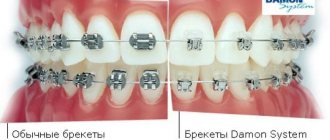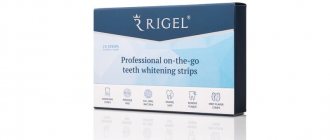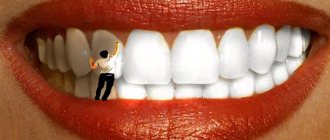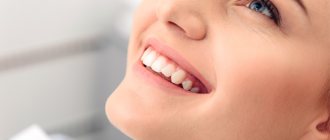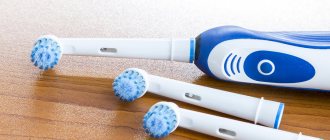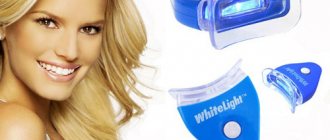From this article you will learn:
- whitening strips – reviews, before and after photos,
- differences between Crest and Blendamed strips,
- price of strips in a pharmacy for 2022.
The article was written by a dentist with more than 19 years of experience.
Whitening strips are designed for chemical teeth whitening at home. The whitening effect is achieved due to hydrogen peroxide, which is applied in the form of a gel to the inner surface of the strips. Their advantages include ease of use, good effectiveness, and a much more affordable price compared to whitening at the dentist.
In Russia, the most well-represented strips for teeth whitening are produced under the brands “Crest 3D White” and “Blendamed 3D White Luxe”. This creates the illusion of choice, but in fact both brands are owned by the same (USA). Compared to Blendamed strips, Crest strips have a higher concentration of hydrogen peroxide.
Teeth whitening strips Crest 3D White and Blendamed 3D White Luxe are good marketing products. You don't have to go to the dentist. It is much cheaper than in the clinic. But why then are the reviews of a fairly large part of patients on teeth whitening strips still far from enthusiastic? In this article we will talk not only about the undoubted advantages of their use, but also the problems that you may encounter.
How do teeth whitening strips work?
Most home teeth whitening systems contain hydrogen peroxide or carbamide peroxide as an active ingredient. Different types of Crest 3D White strips contain different concentrations of hydrogen peroxide - from 9.5 to 14% (we will discuss each type of Crest strips in detail below), and Blendamed 3D White Luxe whitening strips contain 5.25% hydrogen peroxide.
Solutions of hydrogen peroxide and carbamide peroxide are capable of penetrating deeply into tooth tissue with prolonged exposure - to the entire thickness of enamel and dentin. Having penetrated inside, these peroxide compounds decompose there to form free radicals (active oxygen). It is free radicals that lead to the destruction of molecules of chromogenic substances, which give teeth pigmentation.
However, free radicals are not stable compounds and quickly decompose. Therefore, to obtain a whitening effect, hydrogen peroxide must be in contact with the teeth for a sufficiently long time, and it is also necessary to maintain a sufficient concentration. The lower the concentration of hydrogen peroxide in the strips, the longer they will have to be used to get the desired effect.
Teeth whiteners on Aliexpress: examples of reviews
As we have already said, whitening products are not effective in every case. On Aliexpress, you need to select them carefully and study the reviews of other buyers. It is the opinion of those who have already placed an order that will help you make your choice. You can find them on a special tab on the product page:
Reviews
Whitening strips Crest 3D White –
Crest strips for teeth whitening (Crest 3D White) - available in 6 different versions. They differ in different concentrations of hydrogen peroxide, the number of strips in the package, and the exposure time of the strips on the teeth. One of the strip options even has a special light source, which apparently should give the consumer the illusion that this product is similar to professional “laser” whitening systems.
But what's really important is that different types of strips hold onto the teeth differently. Some of them can slip on the teeth and do not stick well. When choosing Crest strips, pay attention to the fact that they contain Advanced Seal® technology (allows the strips to adhere firmly to the teeth and not slip on them). Otherwise, the strips will peel off and there will be no close contact of the whitening gel with the enamel surface.
If you have an uneven dentition/crowded teeth, or a pronounced inclination of some teeth, the FlexFit® technology will allow you to achieve good adaptation of the strips to the surfaces of all teeth. In this case, the strips will be slightly elastic (stretch), which will allow them to better adapt to uneven tooth surfaces or uneven dentition shapes. Only Crest 3D White “Supreme FlexFit” strips have this technology. If the strips do not adhere tightly to some surfaces, then the teeth in these areas will remain dark.
FAQ
How to whiten teeth at home? There are different options. You can use folk remedies like lemon peels, baking soda or hydrogen peroxide, but no one guarantees effectiveness and safety for teeth. It is better to use special products: whitening toothpastes (the main thing is not to get carried away, otherwise you will erase the enamel), gels, mouth guards, strips, varnishes. In our selection above, we just talked about the best special products for teeth whitening at home.
How often can you whiten your teeth? It all depends on what product you use. For example, it is better to brush your teeth with whitening toothpaste no more than a couple of times a week for a month - no longer. After the course, you need to let your teeth rest and recover so as not to damage the enamel. The frequency of use of each specific product is indicated in the instructions for it - be sure to read it before use, and if in doubt, consult your dentist.
Whitening strips: reviews
Let’s say right away that the Crest 3D White “Vivid” strips and especially the Blendamed 3D White Luxe will receive the least good reviews. These versions of the strips do not hold onto the teeth well enough, they slide over them, and if salivation is quite active, it will not be possible to fix them well on the teeth at all, as a result of which there will be no necessary tight contact of the whitening gel with the enamel.
The reviews for White Light teeth whitening are satisfactory. In professional whitening techniques, light sources are used to accelerate the breakdown of hydrogen peroxide in the whitening gel into free radicals, and exposure to light is carried out not after, but during the procedure. In Crest 3D White “With Light” strips, the light is used for 10 minutes after the end of the procedure and, thus, it is not intended to activate the whitening gel.
The portable White Light lamp does not have its own whitening effect, because it is a source of light waves in the “blue” range, and only light waves in the ultraviolet range have a slight whitening effect. Therefore, we believe that the light source in these strips is purely a marketing ploy to make this procedure look like professional laser whitening. This allows us to sell 10 sets of Crest White Light strips - at the price of 20-40 sets of similar sets.
Which Crest strips are better –
We consider the best option for strips to be Crest “Supreme FlexFit”, which is tightly fixed to the teeth and allows the strips to adapt well even in areas of uneven teeth. In 2nd place we would put the Crest “Professional Effects” strips. But we do not recommend using Crest “Supreme Professional” strips with 14% hydrogen peroxide. The fact is that even if the strip does not come into contact with the gums, hydrogen peroxide always gets into the oral fluid due to the contact of the gel with saliva. Therefore, when using a 14% concentration, gum burns and a burning sensation in the throat will be practically guaranteed.
Please note that different versions of strips with the same concentration of hydrogen peroxide of 10% are recommended for different times. Moreover, where the exposure of the strips is 30 minutes, the whitening goes by 3-4 tones, and where the exposure is 60 minutes, by about 6-8 tones. In our opinion, the manufacturer deliberately recommends using essentially the same strips - for different times, so that it does not turn out that cheaper strips will be as effective as more expensive ones.
Crest Professional Effects Strips – Before and After
Crest Vivid strips – before and after photos
CONCLUSIONS: in general, the effectiveness of whitening strips can be very high, and under certain favorable conditions (straight teeth, absence of pigment plaque and dental deposits on the teeth, etc.) - the effect of such home therapy can be practically no different from the result of professional whitening in dentist However, before you buy teeth whitening strips, also read about their disadvantages, which we will tell you about later.
The principle of operation of the product
Whitening strips are impregnated with a special composition containing peroxides - a thin transparent film protects it from contact with the environment. Immediately after its removal, the active release of oxygen ions begins, which provoke oxidative reactions. Organic compounds on the enamel are destroyed, splitting into water and carbon dioxide. As a result, it is possible to eliminate pigmentation and make teeth noticeably whiter. It should be noted that the in-office procedure is carried out according to the same principle, with the only difference being that the active components of the product used are activated under the influence of special light or laser.
Side effects and disadvantages of whitening strips –
Reviews for whitening strips on all sites are written as carbon copies; the texts of the reviews are more like advertising brochures that praise the strips from different angles, keeping silent about the shortcomings. And although home whitening techniques can indeed be very effective, teeth whitening strips still have significant disadvantages...
They do not whiten fillings and crowns -
Chemical whitening allows you to lighten only the tooth tissue. Fillings, veneers, and any types of artificial crowns cannot be bleached. This means that if you have fillings or crowns on one or more teeth, then after whitening they will look even darker against the background of the whitened enamel of the remaining teeth (Fig. 14). Whitening in such situations will mean the need to subsequently replace veneers, crowns and fillings with lighter shades.
It should also be taken into account that after a few months, the teeth will gradually begin to darken again (the speed of teeth darkening after whitening is related to your habits, for example, smoking, the frequency of drinking coloring drinks and foods). This may mean the need for either new replacement fillings, veneers or crowns, or ongoing periodic courses of home whitening.
Uneven whitening –
Reviews of teeth whitening strips are often negative due to the fact that although the front surfaces of the teeth become much whiter, they remain dark in the interdental spaces. This creates a sharp contrast between dark and light, and the interdental spaces end up looking like black triangles (Fig. 15). Why is this happening...
Firstly, the thickness of the whitening gel on the inner surfaces of the strips is only about 0.2 mm. At the same time, the surface of the teeth is not absolutely smooth, and therefore, when adapting the strips to the teeth, the whitening gel simply does not penetrate sufficiently into the interdental spaces. The second reason lies in the uneven position of the teeth, for example, when they are crowded. In this case, adapting the whitening strip to teeth located deeper (lingually) will be very false, which will mean poor contact of the whitening gel with these teeth.
Thirdly, the problem is that most people use Blendamed or Crest whitening strips without first removing plaque and plaque from the dentist. The fact is that the surfaces of teeth covered with pigment plaque whiten a priori much worse, because coating on these areas will prevent hydrogen peroxide from penetrating into them. And therefore the surface of the teeth in these areas will remain dark.
Pain and sensitivity of teeth -
Clinical studies by Cooperetall in 1992 showed that the penetration of free radicals into the dental pulp occurs within 15 minutes after applying 3% hydrogen peroxide gel to tooth enamel. It is this process, as well as a certain degree of demineralization of enamel and dentin, that leads to the development of increased sensitivity of teeth after whitening.
Sensitivity is expressed in the appearance of pain to thermal stimuli (heat, cold). And the longer the bleaching course continues and/or the higher the concentration of hydrogen peroxide, the stronger the sensitivity will be every day. In this case, you can start using special pastes to relieve sensitivity, or reduce the exposure time of the strips on the teeth, or start using them every other time. And after completing the whitening course, it is worth taking a course of remineralization or fluoridation of teeth.
Important: if you have erosions, carious lesions, deep wedge-shaped defects with exposed dentin on your teeth, then you can predict a very high rate of hydrogen peroxide entering the dental pulp (neurovascular bundle) - with the development of severe pain, and even a chemical burn of the pulp , which may then even require removal of the nerve from the tooth. Therefore, caries and wedge-shaped defects must be cured before using whitening strips (24stoma.ru).
Burns and inflammation of the gums, throat irritation -
About half of all patients also complain of sore gums after using whitening strips. The fact is that the whitening strips have a straight shape - in contrast to the gum line, and therefore, when applying the strips to the teeth, they always come into contact with the interdental gingival papillae. As we said above, the strips are coated with a gel with hydrogen peroxide with a concentration of 5.25 to 14% (10% on average), which contributes to the development of a chemical burn of the gums.
Inflammation and burn of gums after whitening –
But gel with hydrogen peroxide can cause harm not only to the gums. The whitening gel is located in the moist environment of the oral cavity, so some of the hydrogen peroxide necessarily gets into the saliva. This means that hydrogen peroxide will affect not only the interdental papillae, but also other areas of the gums and the tongue. In addition, when you swallow saliva, hydrogen peroxide will contact the mucous membrane of the throat, causing irritation. To reduce such side effects, always rinse your mouth after removing strips, reduce exposure time, or use strips with a lower concentration.
White spots on teeth -
When you remove the whitening strips, you can often notice white spots appearing on the enamel. In most cases this is not a problem, because... occurs due to drying out of the enamel area due to the fact that the strips isolate the front surface of the teeth from contact with saliva. Such stains disappear after a few hours (after the enamel is saturated with moisture).
However, if you use low-quality whitening strips (the whitening gel will have an acidic pH), you can end up with chalky white spots on your enamel that will last a lifetime. This can also happen if the enamel of your teeth has poor resistance to chemical and mechanical factors, which occurs against the background of demineralization of the enamel. Generalization means that your enamel contains very little calcium, i.e. as if porous.
If there are white chalky spots on your teeth even before whitening, then this is one of the signs of enamel demineralization, which means that any type of chemical whitening will be contraindicated for you. The use of chemical bleaching against the background of enamel demineralization will lead to an even greater loss of calcium from dental tissues, which will increase the risk of tooth decay (as a result of increased abrasion or the development of caries).
Indications for use
- naturally yellow or even grayish color of enamel,
- pigmentation as a result of smoking and frequent consumption of coloring drinks, such as tea or coffee,
- change in tooth color after removal of orthodontic structures,
- long-term use of powerful medications, which led to darkening of the enamel,
- the desire to make your smile snow-white without visiting a specialist’s office.
Teeth darkened by external factors - an indication for using the method
How harmful are whitening strips to tooth enamel?
Hydrogen peroxide, with prolonged exposure, penetrates not only into the entire depth of enamel and dentin, but even into the dental pulp (neurovascular bundle). There are numerous studies that confirm the slight negative effect of peroxide compounds on tooth tissue...
- Chemical bleaching with hydrogen peroxide can negatively affect the surface texture and shine of the enamel if the gel on the surface of the whitening strips has an acidic pH. In this case, erosions, chalky spots with a matte surface may appear on the enamel surface, and loss of enamel shine may occur. High-quality whitening strips contain sodium hydroxide or its analogues (make the pH neutral).
- Clinical studies by Sighiand Denry 1992 and McCracken et al. 1996 - showed that chemical bleaching leads to a slight decrease in the strength of enamel and its wear resistance to abrasives and chemicals. This occurs due to demineralization of enamel and dentin, i.e. their loss of calcium. Studies have confirmed that the preventive use of a course of fluoride after the end of a whitening course can significantly improve the situation.
- But the most important thing is that chemical whitening disrupts the bond between tooth dentin and filling materials (light composites, glass ionomer cements). This is confirmed by studies by Della Bona et al. 1992, “Tiunsakeretall” 1990, “Titleyetall” 1991. As a result, the marginal fit of the filling to the tooth tissue deteriorates, which can lead to the development of caries at the filling/tooth interface, as well as the need to replace fillings.
Conclusions: whitening strips with a concentration of hydrogen peroxide up to 10% inclusive are a fairly safe product for home use that does not cause critical changes in the teeth (provided that the product has a slightly alkaline pH, there are no carious lesions on the teeth, and also when good oral hygiene). A slight decrease in the degree of mineralization of enamel and dentin can be compensated for by subsequent courses of remineralization and fluoridation of tooth enamel.
Can they harm enamel?
First of all, the enamel may be damaged, but this only happens with cheap, low-quality products and when the technology for conducting whitening sessions is violated. Before starting the course, you need to visit the dentist and make sure that your teeth are completely healthy.
When using a gel with an increased concentration of the active substance, hyperesthesia may be observed, that is, increased sensitivity of the enamel when it begins to react sharply to hot and cold food or drinks, sudden temperature changes in food, as well as chemical food irritants - too salty or, for example, sour products. Usually the discomfort goes away after 3-4 sessions, but if the discomfort only intensifies, you need to urgently stop whitening and make an appointment with a dentist.
Whitening strips: application diagram
Manufacturers of whitening strips recommend not brushing your teeth before using them, arguing that in this case the bacterial film on the surface of the gums will protect them from excessive irritation. This makes a certain sense, but this does not mean at all that you should have food residues in the spaces between your teeth, and traces of soft plaque at the necks of your teeth. Please note that the interdental spaces must be cleaned with dental floss.
1) Preparing to apply the strips - To improve the adherence of the strips to the teeth, you can remove excess saliva from the front surfaces of the teeth using a dry gauze pad.
2) Applying strips - next, take a wider and shorter strip and, having separated it from the protective layer, carefully, without much pressure, apply it with the gel side to the front surface of the lower teeth. The bottom edge of the strip should run along the gum line. After you are sure that the strip is positioned correctly, press it against your teeth for 2-3 seconds.
Then fold the upper edge of the strip over the cutting edge of the lower front teeth and also press for 2-3 seconds. Fix the second (narrower and longer strip) in the same way - on the teeth of the upper jaw. The exposure time of the strips on the teeth is usually from 30 to 60 minutes, according to the type of strips and instructions.
What the overlay of stripes looks like: video
3) Clean your hands – when applying the strips, you will definitely get the hydrogen peroxide gel on your fingertips. The smallest thing that can happen is that your fingertips turn white. It will be much worse if you rub your face with unwashed hands or get the gel into your eyes, or if the gel gets from your hands onto the fur or skin of pets. Also, very often patients spoil their clothes, because... Hydrogen peroxide will permanently lighten areas of tissue where it gets in contact.
4) Additional recommendations - as we said above: hydrogen peroxide will in any case get from the whitening gel on the strips into the oral fluid. To avoid unnecessary irritation of the gums and throat, it is advisable to periodically spit out saliva without swallowing it. This process is not very pleasant, so try to use the strips at times when you are not actively salivating (i.e. not on an empty stomach). A small amount of saliva can be swallowed without fear of the above side effects.
If you begin to feel a burning sensation in your gums or throat, immediately remove the strips and rinse the oral mucosa with plain water. Perhaps next time you will need to reduce the time for fixing the strips on your teeth, or start doing them every other time (this will simply lengthen the whitening course), or purchase strips with a lower concentration of hydrogen peroxide. And lastly, after completing such a home whitening course, always have your enamel fluoridated at the dentist.
Also, during the whitening course, you should give up highly abrasive toothpastes to compensate for the temporary decrease in enamel wear resistance, as well as drinks and foods with a high acid content (wine, fruit juices...), as well as smoking. If you use an electric toothbrush for hygiene, then for some time it is better to use either the attachment for sensitive teeth or the “gentle brushing” mode without pulsating movements.
What effect to expect
According to user reviews, the effect becomes noticeable after 3 sessions, and lasting results can be achieved after 10-14 days of regular procedures. With the help of such strips, you can make the enamel whiter by 1-6 tones - it all depends on the intensity of exposure to the brightening gel and the duration of the course. 1. An activator gel with a low concentration of hydrogen peroxide whitens gradually, usually by 1-4 tones. Products with a high content of active ingredients offer a faster and more pronounced effect - 5-7 tones.
When bleaching with strips, you can achieve lightening of up to 5-7 tones.
Contraindications for bleaching –
The development of allergic reactions to the whitening strips Cross and Blendamed is possible. If you are allergic to any of the components, you must avoid using them. There are also a number of diseases and conditions in which the use of whitening strips will be contraindicated.
Contraindications to whitening strips –
- presence of enamel erosions,
- the presence of areas of enamel demineralization (in the form of white chalky spots),
- the presence of untreated caries,
- with the frequent appearance of new carious lesions,
- the presence of deep wedge-shaped defects with exposure of dentin,
- during pregnancy and breastfeeding,
- for diabetes mellitus,
- You must stop smoking for the entire whitening period.
- with severe degrees of fluorosis, enamel hypoplasia or tetracycline staining,
- in adolescents under 18 years of age (at this age there is still a large volume of pulp chambers, which can lead to a chemical burn of the pulp and the need for tooth depulpation).
Precautionary measures
Before using tooth whitening strips, be sure to review all side effects, ensure there is no allergic reaction, and take all precautions for using the product in question.
What is necessary:
- mandatory visit to the dentist and receipt of preliminary recommendations from him;
- select and purchase strips as prescribed by a doctor;
- If there are contraindications or allergic reactions, do not use whitening strips;
- it is necessary to strictly observe all medical recommendations and strictly follow the instructions for users;
- strictly observe the time for applying the strip to tooth enamel;
- preliminary brushing of teeth before the procedure is prohibited;
- while using the strips, you must avoid drinking tea, coffee, or any coloring foods;
- contact of the active gel with the soft tissues of the oral cavity is contraindicated;
- Avoid swallowing strips and saliva released during whitening.
Do they harm your teeth?
Manufacturers of whitening plates, when developing them, took into account all the dangerous aspects that lead to damage to enamel, gums and teeth. Therefore, the gel includes additional components that smooth out the effect of hydrogen peroxide. In strips for self-whitening enamel, the active substance content is significantly less than in products for professional use. If all conditions specified in the instructions are met, they cannot harm tooth enamel.
Advantages
Lamellar products for enamel whitening are attractive for many reasons:
- they are easy to use, so they can be used independently;
- allow you to quickly get the desired result;
- do not destroy enamel;
- safe to use;
- the result lasts for a long time (up to 1.5 years).
The best systems from AliExpress with whitening gel
A teeth whitening system is a kit that consists of a gel or strips containing at least 10% carbamide or hydrogen peroxide, an LED or infrared lamp and a custom tray. Whitening occurs due to the release of active oxygen under the influence of light radiation from a lamp.
The bleach is applied using a tray, then the lamp is turned on. The enamel pores open, active oxygen penetrates inside and removes darkening. After the procedure, the dentinal tubules remain open, so some manufacturers complete kits with products containing minerals that strengthen the enamel (hydroxyapatite, calcium, potassium, magnesium).
